Capitol Records MONO Original Released
#02 The Beatles' Second Album (T-2080)
(Update: 2nd. October 2024)


 Capitol 1st. Sleeve |
|
|
|
TITLE
|
THE BEATLES' SECOND ALBUM |
||||||||||||||||||||||||||||||||||
| CATALOG
NUMBER |
T-2080 |
||||||||||||||||||||||||||||||||||
|
RELEASE DATE
|
10th April.1964/First Press / Decca
Contract Press? |
||||||||||||||||||||||||||||||||||
| TITLE LISTING |
SIDE
1 |
SIDE
2 |
|||||||||||||||||||||||||||||||||
| Roll Over
Beethoven (BMI-2:44) |
Long Tall Sally (BMI) |
||||||||||||||||||||||||||||||||||
| Thank You Girl (BMI-2:01) | I Call Your Name
(ASCAP) |
||||||||||||||||||||||||||||||||||
| You Really Got A Hold On Me (BMI-2:58) | Please Mister Postman (BMI-2:34) | ||||||||||||||||||||||||||||||||||
| Devil In Her Heart (BMI-2:23) | I'll Get You
(ASCAP-2:04) |
||||||||||||||||||||||||||||||||||
| Money (That's What I Want) (BMI-2:47) | She Loves You
(ASCAP-2:19) |
||||||||||||||||||||||||||||||||||
| You Can't Do That
(ASCAP-2:33) |
|||||||||||||||||||||||||||||||||||
| FRONT--> Click! | BACK --> Click! | SIDE 1 --> Click! | SIDE 2 --> Click! | DISK --> Click! | |||||||||||||||||||||||||||||||
 |
 |
 |
 |
 |
|||||||||||||||||||||||||||||||
| INNER SLEEVE | FRONT COVER CLOSE UP | ||||||||||||||||||||||||||||||||||
| FRONT --> Click |
BACK --> Click! |
||||||||||||||||||||||||||||||||||
 |
 |
 |
|||||||||||||||||||||||||||||||||
| The exposed portion of the back liner
that wrapped around to the top of the jacket has the phrase
"File Under: The Beatles • Pop Rock, Vocal Group" as well as
a large black dot and the catalogue number. |
|||||||||||||||||||||||||||||||||||
| FRONT COVER CLOSE UP | BACK COVER CLOSE UP | ||||||||||||||||||||||||||||||||||
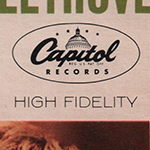 |
The Capitol logo and the phrase "HIGH FIDELITY" appear in black at the right side of the front cover. | 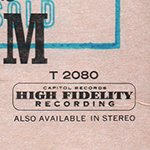 |
 |
||||||||||||||||||||||||||||||||
| Back liner has the catalogue number "T 2080", the "Capitol Records High Fidelity Recording" logo and "Also Available In Stereo" in uppercase letters in the upper right corner. | |||||||||||||||||||||||||||||||||||
| BACK COVER CLOSE UP | |||||||||||||||||||||||||||||||||||
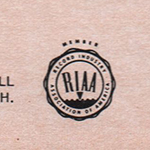 |
 |
||||||||||||||||||||||||||||||||||
| The
lower portion of the back liner contains "MADE IN U.S.A. •
FACTORIES: SCRANTON, PA. - LOS ANGELES, CALIF." and the RIAA
(Record Industry Association of America" logo. Most of the back liners have a small numeral located near the lower right or left corner. These numbers were used by Capitol to identify where the album cover was manufactured. (Back liners were sometimes printed without any identification number.) |
|||||||||||||||||||||||||||||||||||
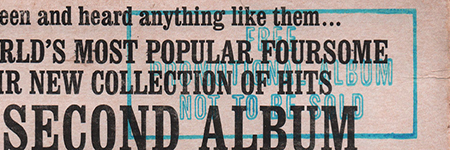 |
Capitol normally marked the
covers of its albums allocated for promotional use. This was
done to prevent these albums, which were distributed to
radio stations and reviewers at no cost, from being sold.
Due to the dominance of mono in the early sixties, nearly
all of the promotional albums were mono. The promotional
copies of the first two Beatles albums were marked on the
back covers with ink stamps. |
||||||||||||||||||||||||||||||||||
| LABEL CLOSE UP | |||||||||||||||||||||||||||||||||||
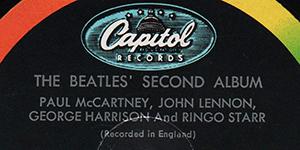 |
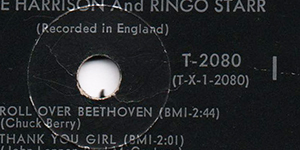 |
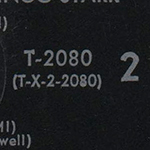 |
|||||||||||||||||||||||||||||||||
| The original issue Capitol albums were manufactured with black label backdrops with an outer rim colorband. | Catalogue
number "T-2080" was printed at the right side of the center
hole. The labels for records manufactured on the East Coast
were printed by Keystone Printed Specialties, Inc. in
Scranton, Pennsylvania. The labels for the West Coast were
printed by Bert-Co Enterprises in Los Angeles, California.
The labels can be differentiated by the font of the number
"one" at nine o’clock on the side one labels. |
||||||||||||||||||||||||||||||||||
| LABEL CLOSE UP | |||||||||||||||||||||||||||||||||||
| SIDE 1 --> Click! |
SIDE 2 --> Click! |
The
initial mono labels do not have running times for
Long Tall Sally or I Call Your Name and list ASCAP as the
performing rights organization for I Call Your Name. |
|||||||||||||||||||||||||||||||||
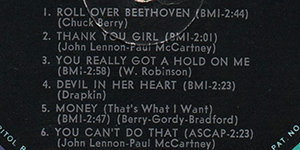 |
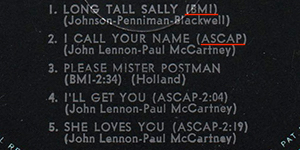 |
||||||||||||||||||||||||||||||||||
| LABEL CLOSE UP | |||||||||||||||||||||||||||||||||||
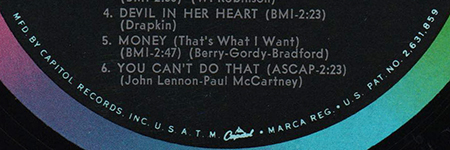 |
The text of the perimeter print in blue on the original issue discs states "MFD. BY CAPITOL RECORDS. INC. U.S.A. T.M." to the left of a small Capitol logo, with "• MARCA REG. • U.S. PAT. NO. 2, 631,859" to the right. On some labels, the perimeter print is in white. | ||||||||||||||||||||||||||||||||||
|
OTHER ITEM
|
|||||||||||||||||||||||||||||||||||
| - | |||||||||||||||||||||||||||||||||||
| LABEL | Capitol
Black
label with color band Type-1 |
||||||||||||||||||||||||||||||||||
| MIX | MONO |
||||||||||||||||||||||||||||||||||
| VINYL COLOR | Black |
||||||||||||||||||||||||||||||||||
| PRESS FACTORY |
SLEEVE | East
Coast: Queens Litho in New York |
|||||||||||||||||||||||||||||||||
| VINYL | Decca?
Pinckneyville, Illinois / LABEL: Keystone Printed
Specialties, Inc. in Scranton, Pensylvania. |
||||||||||||||||||||||||||||||||||
| FACTORY CODE | None |
||||||||||||||||||||||||||||||||||
| MATRIX No. | SIDE 1 |
T 1
2080 H21 D (P?) (hand
etched) |
|||||||||||||||||||||||||||||||||
| SIDE 2 |
T 2 2080 G23 D (P?) (hand etched) | ||||||||||||||||||||||||||||||||||
| PUBLISHER'S NAME |
- |
||||||||||||||||||||||||||||||||||
|
"SUBSIDIARY" PRINT
|
- |
||||||||||||||||||||||||||||||||||
| COVER FORM |
Single
type.
Housed in a cardboard jacket. |
||||||||||||||||||||||||||||||||||
| INNER SLEEVE | Capitol
Company Sleeve Type-2: Light Blue sleeve |
||||||||||||||||||||||||||||||||||
| COVER DESIGN/ PHOTO/ NOTES | Front
Cover
Design: George Osaki All Photos: Joe Covello / Black Star |
||||||||||||||||||||||||||||||||||
| PRODUCER | Produced
in
London by George Martin |
||||||||||||||||||||||||||||||||||
|
COMMENTS
|
The Beatles' Second Album is the
Beatles' second Capitol Records album, and their third album
released in the United States including Introducing... The
Beatles released three months earlier on Vee-Jay Records.
The Beatles' Second Album replaced Meet the Beatles! at
number one on the album charts in the US. The white front cover to "The Beatles' Second Album" , which was also designed by George Osaki, features a layout of sepia-tinted photographs of the band. There are two group shots: one posing in front of a curtain at The Ed Sullivan Show and one from the Kennedy airport press conference. All photos were taken by Joe Covello and licensed through Black Star. The initial slicks have the group's name in a brownish red and the song titles in dark green. Later slicks have "THE BEATLES" in bright red and the song titles in olive green. The black and white back liner also features photographs of the band. Four of the pictures feature Ed Sullivan Show performances. Three is also a performance shot from the Washington Coliseum concert. The minor color variation among covers is due to the front slicks being prepared by differeint printers. Front slicks were printed on: 1-1) East Coast: Queens Litho in New York 1-2) East Coast: Ivy Hill Lithograph Co. in New York 2) West Coast: Bert-Co Enterprise of Los Angeles. When "The Beatles' Second Album" was originally issued, Capitol had factories in 1) Scranton, Pensylvania 2) Los Angeles, California 3) In mid. 1965, added a pressing plant in Jacksonville, Illinois. (Stereo Only) The lower portion of the back liner contains "MADE IN U.S.A. • FACTORIES: SCRANTON, PA. - LOS ANGELES, CALIF." and the RIAA (Record Industry Association of America) logo. Most of the back liners have a small numeral located near the lower right or left corner. These numbers were used by Capitol to identify where the album cover was manufactured. Capitol did not fabricate its own album covers. Capitol required the cover manufacturer to place a factory identification number on the back liners. The fabricators added a small number, usually in the lower right corner. The following tables detail the cover numbers that are known to exist: Compiled by Frank Daniels in 2012 The Beatles' Second Album (S)T-2080
The original issue Capitol albums were manufactured with black label backdrops with an outer rim colorband. Label copy information specific to each album appears in silver print. The labels for records manufactured on: 1) The East Coast were printed by Keystone Printed Specialties, Inc. in Scranton, Pensylvania. 2) The West Coast were printed by Bert-Co Enterprises in Los Angeles, California. Because the label copy for the record was prepared prior to Capitol receiving the master tapes for the two newly recorded songs, Long Tall Sally and I Call Your Name, the labels to the first pressings do not list the times for these songs. In fact, except for a few scarce variations, later pressings are also missing the times for these songs even though the information was available. There are East Coast and West Coast label variations. 1) The initial mono labels do not have running times for Long Tall Sally or I Call Your Name and list ASCAP as the performing rights organization for I Call Your Name. (East Coast and West Coast) 2) After Capitol received the tapes for Long Tall Sally and I Call Your Name, the company was able to revise the label copy by adding the running time for the two songs. Only East Coast mono labels have been confirmed with running times for Long Tall Sally and I Call Your Name. This variation was changed the credit "She Loves You" to BMI. (East Coast only) In order to meet the huge demand for Beatles records, Capitol subcontracted with other companies to press its albums. The three companies most frequently used by Capitol were the former Big Three — Columbia, Decca and RCA. Columbia manufactured albums for Capitol at its factories in Pitman, New Jersey, Terre Haute, Indiana, and Santa Maria, California. Columbia LPs have a 2 11/16"-diameter ring located 1 3/16" from the center hole. The trail off areas have hand etched matrix and lacquer numbers. Columbia discs pressed in California have Bert-Co labels while those manufactured in Pitman and Terre Haute have Keystone labels. Pitman pressings have a machine stamped “P” in their trail off areas. Columbia LPs with “54” hand etched in their trail off areas were probably pressed in Terre Haute. Decca pressings have a single ring with a diameter of just under 1" located 5/16" from the spindle hole. The trail off areas have hand etched matrix and lacquer numbers followed by a plant identification letter (“P” for Pinckneyville, Illinois, or “G” for Gloversville, New York). Some earlier Decca pressings have a 2 3/4" diameter ring in addition to the 1" diameter ring. RCA pressings have an indented 2¾"-diameter groove that is 1¼" from the spindle hole. The West Coast RCA discs were pressed in Hollywood with Bert-Co labels. They normally have hand etched matrix and lacquer numbers and a hand etched “W” in their trail off areas. RCA albums manufactured in Rockaway, New Jersey, and Indianapolis, Indiana, have Keystone labels. The Rockaway disc trail off areas have machine stamped matrix and lacquer numbers followed by "R1" and a hand etched "RR." |
||||||||||||||||||||||||||||||||||
|
TITLE
|
THE BEATLES' SECOND ALBUM |
||||||||||||||||||||||||||||||||||
| CATALOG
NUMBER |
T-2080 |
||||||||||||||||||||||||||||||||||
|
RELEASE DATE
|
10th April.1964/First Press / RCA Contract
Press? |
||||||||||||||||||||||||||||||||||
| TITLE LISTING |
SIDE
1 |
SIDE
2 |
|||||||||||||||||||||||||||||||||
| Roll Over
Beethoven (BMI-2:44) |
Long Tall Sally (BMI) |
||||||||||||||||||||||||||||||||||
| Thank You Girl (BMI-2:01) | I Call Your Name
(ASCAP) |
||||||||||||||||||||||||||||||||||
| You Really Got A Hold On Me (BMI-2:58) | Please Mister Postman (BMI-2:34) | ||||||||||||||||||||||||||||||||||
| Devil In Her Heart (BMI-2:23) | I'll Get You
(ASCAP-2:04) |
||||||||||||||||||||||||||||||||||
| Money (That's What I Want) (BMI-2:47) | She Loves You
(ASCAP-2:19) |
||||||||||||||||||||||||||||||||||
| You Can't Do That
(ASCAP-2:33) |
|||||||||||||||||||||||||||||||||||
| FRONT--> Click! | BACK --> Click! | SIDE 1 --> Click! | SIDE 2 --> Click! | DISK | |||||||||||||||||||||||||||||||
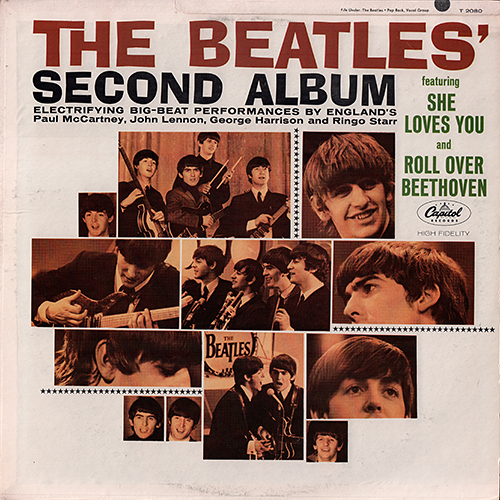 |
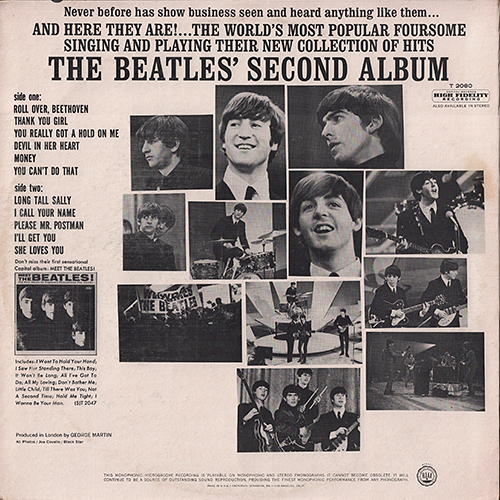 |
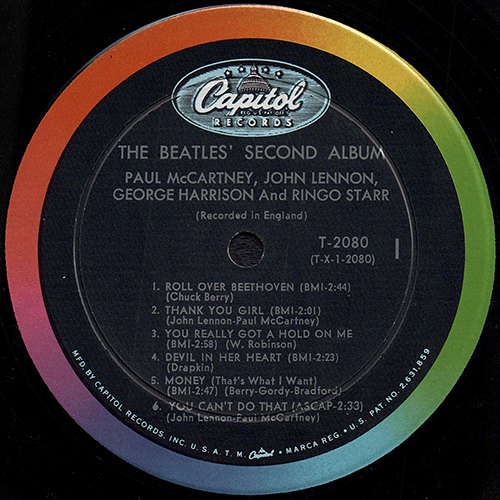 |
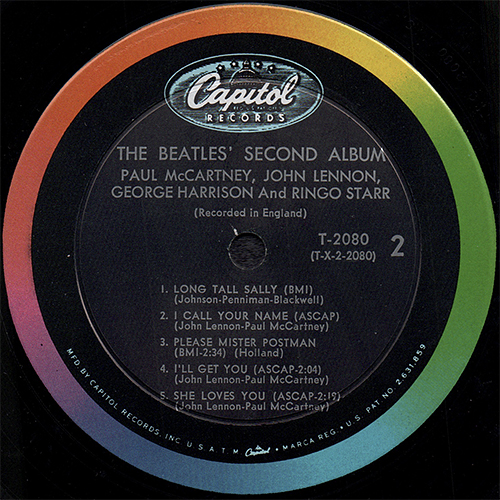 |
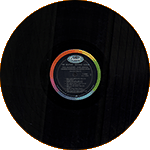 |
|||||||||||||||||||||||||||||||
| INNER SLEEVE | FRONT COVER CLOSE UP | ||||||||||||||||||||||||||||||||||
| FRONT --> Click |
BACK --> Click! |
||||||||||||||||||||||||||||||||||
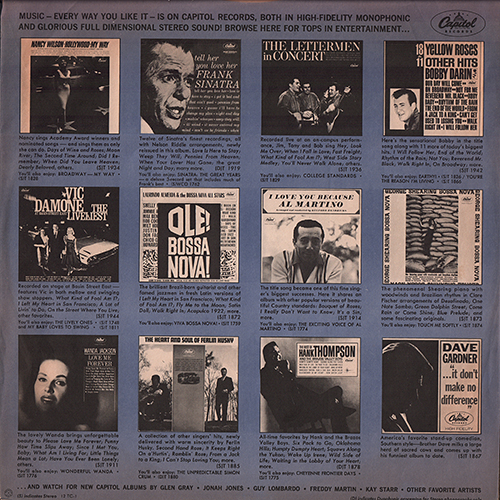 |
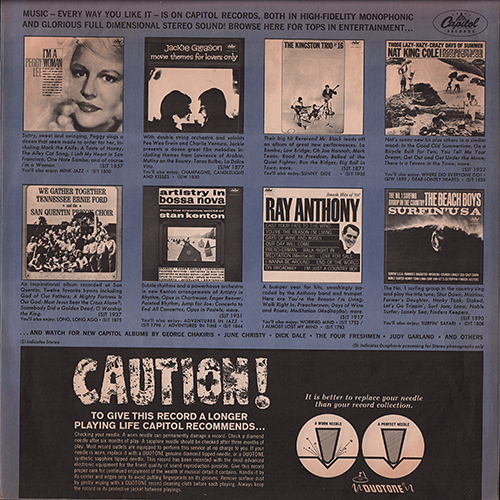 |
 |
|||||||||||||||||||||||||||||||||
| The exposed portion of the back liner
that wrapped around to the top of the jacket has the phrase
"File Under: The Beatles • Pop Rock, Vocal Group" as well as
a large black dot and the catalogue number. |
|||||||||||||||||||||||||||||||||||
| FRONT COVER CLOSE UP | BACK COVER CLOSE UP | ||||||||||||||||||||||||||||||||||
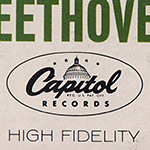 |
The Capitol logo and the phrase "HIGH FIDELITY" appear in black at the right side of the front cover. | 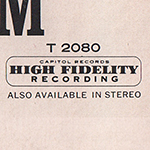 |
 |
||||||||||||||||||||||||||||||||
| Back liner has the catalogue number "T 2080", the "Capitol Records High Fidelity Recording" logo and "Also Available In Stereo" in uppercase letters in the upper right corner. | |||||||||||||||||||||||||||||||||||
| BACK COVER CLOSE UP | |||||||||||||||||||||||||||||||||||
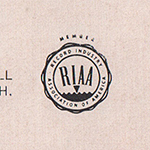 |
 |
||||||||||||||||||||||||||||||||||
| The
lower portion of the back liner contains "MADE IN U.S.A. •
FACTORIES: SCRANTON, PA. - LOS ANGELES, CALIF." and the RIAA
(Record Industry Association of America" logo. Most of the back liners have a small numeral located near the lower right or left corner. These numbers were used by Capitol to identify where the album cover was manufactured. (Back liners were sometimes printed without any identification number.) |
|||||||||||||||||||||||||||||||||||
| LABEL CLOSE UP | |||||||||||||||||||||||||||||||||||
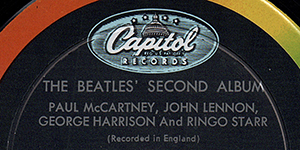 |
The original issue Capitol albums
were manufactured with black label backdrops with an outer
rim colorband. |
 |
|||||||||||||||||||||||||||||||||
| Catalogue number
"T-2080" was printed at the right side of the center hole. |
|||||||||||||||||||||||||||||||||||
| LABEL CLOSE UP | |||||||||||||||||||||||||||||||||||
| SIDE 1 --> Click! |
SIDE 2 --> Click! |
The
initial
mono labels do not have running times for Long Tall
Sally or I Call Your Name and list ASCAP as the performing
rights organization for I Call Your Name. |
|||||||||||||||||||||||||||||||||
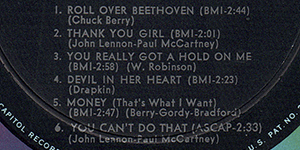 |
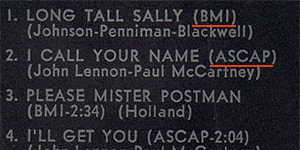 |
||||||||||||||||||||||||||||||||||
| LABEL CLOSE UP | |||||||||||||||||||||||||||||||||||
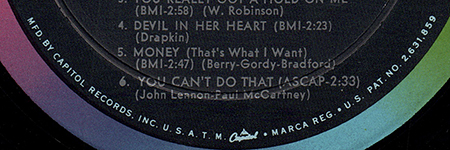 |
The text of the perimeter print in blue on the original issue discs states "MFD. BY CAPITOL RECORDS. INC. U.S.A. T.M." to the left of a small Capitol logo, with "• MARCA REG. • U.S. PAT. NO. 2, 631,859" to the right. On some labels, the perimeter print is in white. | ||||||||||||||||||||||||||||||||||
|
OTHER ITEM
|
|||||||||||||||||||||||||||||||||||
| - | |||||||||||||||||||||||||||||||||||
| LABEL | Capitol
Black
label
with color band Type-1 |
||||||||||||||||||||||||||||||||||
| MIX | MONO |
||||||||||||||||||||||||||||||||||
| VINYL COLOR | Black |
||||||||||||||||||||||||||||||||||
| PRESS FACTORY |
SLEEVE | East
Coast: Queens Litho in New York |
|||||||||||||||||||||||||||||||||
| VINYL | RCA?
Rockaway, New Jersey, and Indianapolis, Indiana / LABEL:
Keystone Printed Specialties, Inc. in Scranton, Pensylvania. |
||||||||||||||||||||||||||||||||||
| FACTORY CODE | None |
||||||||||||||||||||||||||||||||||
| MATRIX No. | SIDE 1 |
A6
R
TX1
2080 J14 (machine stamped) |
|||||||||||||||||||||||||||||||||
| SIDE 2 |
1 R A4 TX2 2080 F15 (machine stamped) | ||||||||||||||||||||||||||||||||||
| PUBLISHER'S NAME |
- |
||||||||||||||||||||||||||||||||||
|
"SUBSIDIARY" PRINT
|
- |
||||||||||||||||||||||||||||||||||
| COVER FORM |
Single
type.
Housed
in a cardboard jacket. |
||||||||||||||||||||||||||||||||||
| INNER SLEEVE | Capitol
Company
Sleeve
Type-1: Royal Blue sleeve |
||||||||||||||||||||||||||||||||||
| COVER DESIGN/ PHOTO/ NOTES | Front
Cover
Design:
George Osaki All Photos: Joe Covello / Black Star |
||||||||||||||||||||||||||||||||||
| PRODUCER | Produced
in
London
by George Martin |
||||||||||||||||||||||||||||||||||
|
COMMENTS
|
The Beatles' Second Album is the
Beatles' second Capitol Records album, and their third album
released in the United States including Introducing... The
Beatles released three months earlier on Vee-Jay Records.
The Beatles' Second Album replaced Meet the Beatles! at
number one on the album charts in the US. The white front cover to "The Beatles' Second Album" , which was also designed by George Osaki, features a layout of sepia-tinted photographs of the band. There are two group shots: one posing in front of a curtain at The Ed Sullivan Show and one from the Kennedy airport press conference. All photos were taken by Joe Covello and licensed through Black Star. The initial slicks have the group's name in a brownish red and the song titles in dark green. Later slicks have "THE BEATLES" in bright red and the song titles in olive green. The black and white back liner also features photographs of the band. Four of the pictures feature Ed Sullivan Show performances. Three is also a performance shot from the Washington Coliseum concert. The minor color variation among covers is due to the front slicks being prepared by differeint printers. Front slicks were printed on: 1-1) East Coast: Queens Litho in New York 1-2) East Coast: Ivy Hill Lithograph Co. in New York 2) West Coast: Bert-Co Enterprise of Los Angeles. When "The Beatles' Second Album" was originally issued, Capitol had factories in 1) Scranton, Pensylvania 2) Los Angeles, California 3) In mid. 1965, added a pressing plant in Jacksonville, Illinois. (Stereo Only) The lower portion of the back liner contains "MADE IN U.S.A. • FACTORIES: SCRANTON, PA. - LOS ANGELES, CALIF." and the RIAA (Record Industry Association of America) logo. Most of the back liners have a small numeral located near the lower right or left corner. These numbers were used by Capitol to identify where the album cover was manufactured. Capitol did not fabricate its own album covers. Capitol required the cover manufacturer to place a factory identification number on the back liners. The fabricators added a small number, usually in the lower right corner. The following tables detail the cover numbers that are known to exist: Compiled by Frank Daniels in 2012 The Beatles' Second Album (S)T-2080
The original issue Capitol albums were manufactured with black label backdrops with an outer rim colorband. Label copy information specific to each album appears in silver print. The labels for records manufactured on: 1) The East Coast were printed by Keystone Printed Specialties, Inc. in Scranton, Pensylvania. 2) The West Coast were printed by Bert-Co Enterprises in Los Angeles, California. Because the label copy for the record was prepared prior to Capitol receiving the master tapes for the two newly recorded songs, Long Tall Sally and I Call Your Name, the labels to the first pressings do not list the times for these songs. In fact, except for a few scarce variations, later pressings are also missing the times for these songs even though the information was available. There are East Coast and West Coast label variations. 1) The initial mono labels do not have running times for Long Tall Sally or I Call Your Name and list ASCAP as the performing rights organization for I Call Your Name. (East Coast and West Coast) 2) After Capitol received the tapes for Long Tall Sally and I Call Your Name, the company was able to revise the label copy by adding the running time for the two songs. Only East Coast mono labels have been confirmed with running times for Long Tall Sally and I Call Your Name. This variation was changed the credit "She Loves You" to BMI. (East Coast only) In order to meet the huge demand for Beatles records, Capitol subcontracted with other companies to press its albums. The three companies most frequently used by Capitol were the former Big Three — Columbia, Decca and RCA. Columbia manufactured albums for Capitol at its factories in Pitman, New Jersey, Terre Haute, Indiana, and Santa Maria, California. Columbia LPs have a 2 11/16"-diameter ring located 1 3/16" from the center hole. The trail off areas have hand etched matrix and lacquer numbers. Columbia discs pressed in California have Bert-Co labels while those manufactured in Pitman and Terre Haute have Keystone labels. Pitman pressings have a machine stamped “P” in their trail off areas. Columbia LPs with “54” hand etched in their trail off areas were probably pressed in Terre Haute. Decca pressings have a single ring with a diameter of just under 1" located 5/16" from the spindle hole. The trail off areas have hand etched matrix and lacquer numbers followed by a plant identification letter (“P” for Pinckneyville, Illinois, or “G” for Gloversville, New York). Some earlier Decca pressings have a 2 3/4" diameter ring in addition to the 1" diameter ring. RCA pressings have an indented 2¾"-diameter groove that is 1¼" from the spindle hole. The West Coast RCA discs were pressed in Hollywood with Bert-Co labels. They normally have hand etched matrix and lacquer numbers and a hand etched “W” in their trail off areas. RCA albums manufactured in Rockaway, New Jersey, and Indianapolis, Indiana, have Keystone labels. The Rockaway disc trail off areas have machine stamped matrix and lacquer numbers followed by "R1" and a hand etched "RR." |
||||||||||||||||||||||||||||||||||
|
TITLE
|
THE BEATLES' SECOND ALBUM |
||||||||||||||||||||||||||||||||||
| CATALOG
NUMBER |
T-2080 |
||||||||||||||||||||||||||||||||||
|
RELEASE DATE
|
10th April.1964/First Press | ||||||||||||||||||||||||||||||||||
| TITLE LISTING |
SIDE
1 |
SIDE
2 |
|||||||||||||||||||||||||||||||||
| Roll Over
Beethoven (BMI-2:44) |
Long Tall Sally (BMI) |
||||||||||||||||||||||||||||||||||
| Thank You Girl (BMI-2:01) | I Call Your Name
(ASCAP) |
||||||||||||||||||||||||||||||||||
| You Really Got A Hold On Me (BMI-2:58) | Please Mister Postman (BMI-2:34) | ||||||||||||||||||||||||||||||||||
| Devil In Her Heart (BMI-2:23) | I'll Get You
(ASCAP-2:04) |
||||||||||||||||||||||||||||||||||
| Money (That's What I Want) (BMI-2:47) | She Loves You
(ASCAP-2:19) |
||||||||||||||||||||||||||||||||||
| You Can't Do That
(ASCAP-2:33) |
|||||||||||||||||||||||||||||||||||
| FRONT--> Click! | BACK --> Click! | SIDE 1 --> Click! | SIDE 2 --> Click! | DISK | |||||||||||||||||||||||||||||||
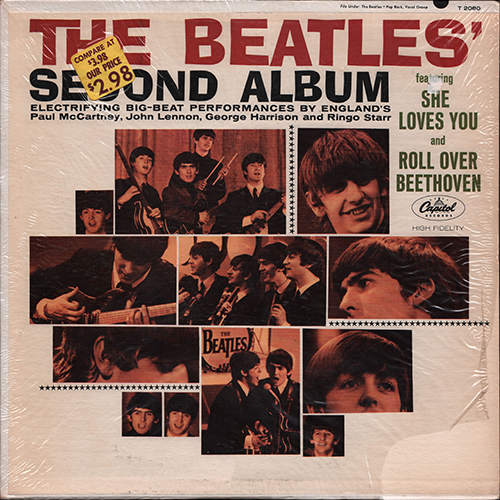 |
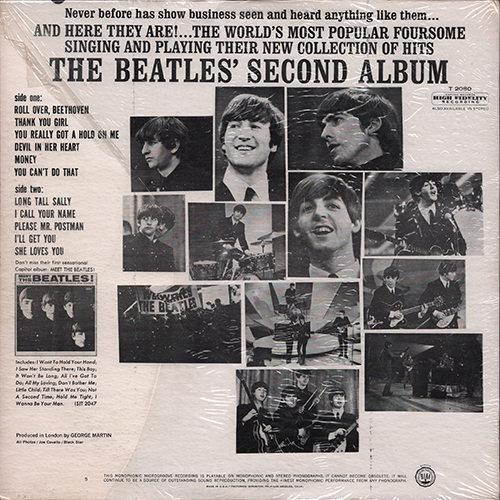 |
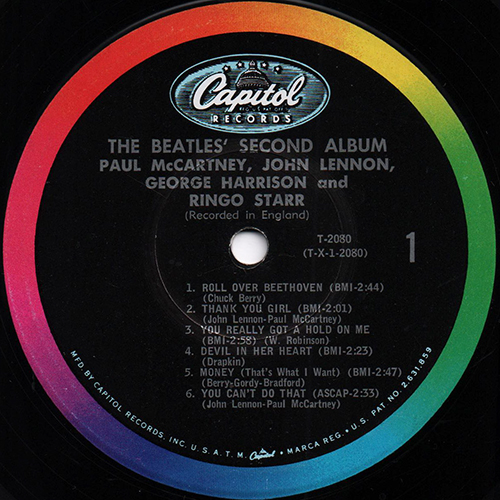 |
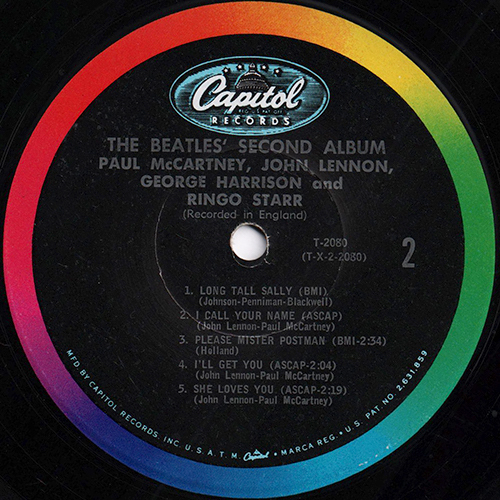 |
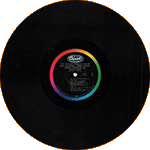 |
|||||||||||||||||||||||||||||||
| INNER SLEEVE | FRONT COVER CLOSE UP | ||||||||||||||||||||||||||||||||||
| FRONT --> Click |
BACK --> Click! |
||||||||||||||||||||||||||||||||||
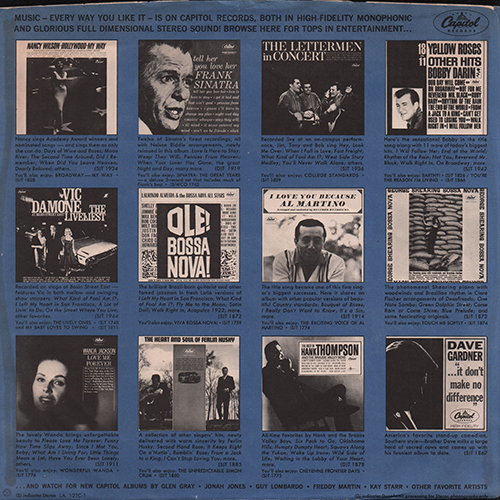 |
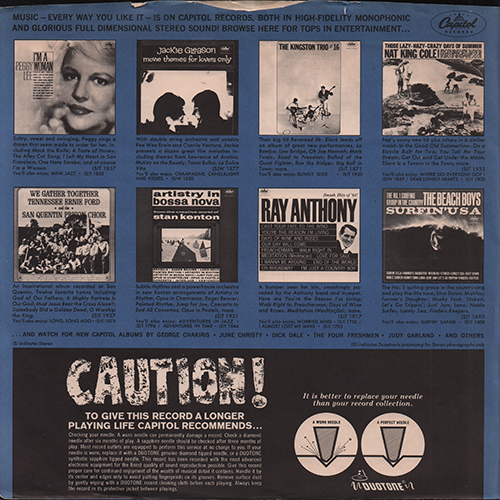 |
 |
|||||||||||||||||||||||||||||||||
| The exposed portion of the back liner
that wrapped around to the top of the jacket has the phrase
"File Under: The Beatles • Pop Rock, Vocal Group" as well as
a large black dot and the catalogue number. |
|||||||||||||||||||||||||||||||||||
| FRONT COVER CLOSE UP | |||||||||||||||||||||||||||||||||||
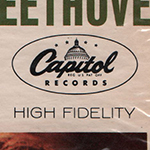 |
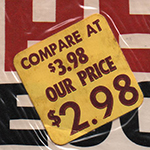 |
The Capitol logo and the phrase "HIGH
FIDELITY" appear in black at the right side of the front
cover. Shop price sticker was paseted. |
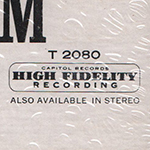 |
Back liner has the catalogue number "T 2080", the "Capitol Records High Fidelity Recording" logo and "Also Available In Stereo" in uppercase letters in the upper right corner. | |||||||||||||||||||||||||||||||
| BACK COVER CLOSE UP | |||||||||||||||||||||||||||||||||||
 |
The left side of the back
cover has the credits: “Produced in London by GEORGE MARTIN”
and "All Photos/Joe Covello/Black Star". |
||||||||||||||||||||||||||||||||||
| BACK COVER CLOSE UP | |||||||||||||||||||||||||||||||||||
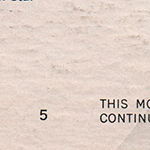 |
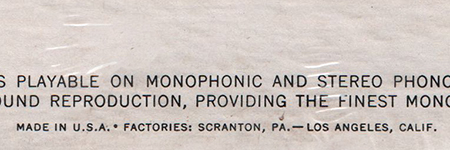 |
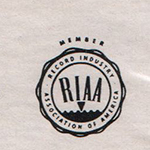 |
|||||||||||||||||||||||||||||||||
| The lower portion of the back
liner contains "MADE IN U.S.A. • FACTORIES: SCRANTON, PA. -
LOS ANGELES, CALIF." and the RIAA (Record Industry
Association of America" logo. Most of the back liners have a small numeral located near the lower right or left corner. These numbers were used by Capitol to identify where the album cover was manufactured. (5=Los Angeles factory) |
|||||||||||||||||||||||||||||||||||
| LABEL CLOSE UP | |||||||||||||||||||||||||||||||||||
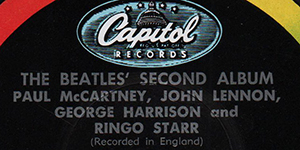 |
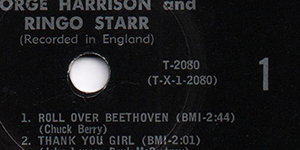 |
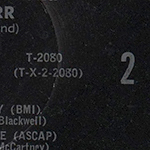 |
|||||||||||||||||||||||||||||||||
| The original issue
Capitol albums were manufactured with black label backdrops
with an outer rim colorband. |
The labels for the West Coast were printed by Bert-Co Enterprises in Los Angeles, California. The labels can be differentiated by the font of the number "one" at nine o’clock on the side one labels. | ||||||||||||||||||||||||||||||||||
| LABEL CLOSE UP | |||||||||||||||||||||||||||||||||||
| SIDE 1 --> Click! | SIDE 2 --> Click! | ||||||||||||||||||||||||||||||||||
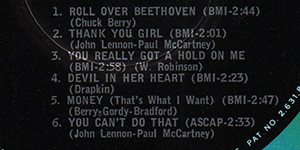 |
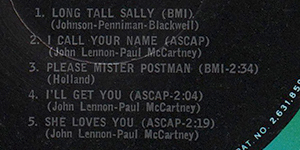 |
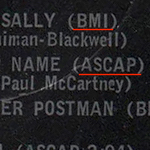 |
|||||||||||||||||||||||||||||||||
| Because the label copy for the
record was prepared prior to Capitol receiving the master
tapes for the two newly recorded songs, Long Tall Sally and
I Call Your Name, the labels to the first pressings do not
list the times for these songs. In fact, except for a few
scarce variations, later pressings are also missing the
times for these songs even though the information was
available. The initial mono labels do not have running times for Long Tall Sally or I Call Your Name and list ASCAP as the performing rights organization for I Call Your Name. After Capitol received the tapes for Long Tall Sally and I Call Your Name, the company was able to revise the label copy by adding the running time for the two songs. Only East Coast mono labels have been confirmed with running times for Long Tall Sally and I Call Your Name. |
|||||||||||||||||||||||||||||||||||
| LABEL CLOSE UP | |||||||||||||||||||||||||||||||||||
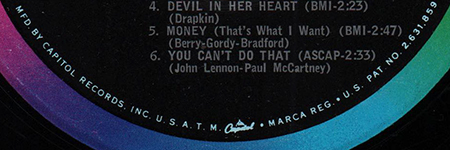 |
The text of the perimeter print in blue on the original issue discs states "MFD. BY CAPITOL RECORDS. INC. U.S.A. T.M." to the left of a small Capitol logo, with "• MARCA REG. • U.S. PAT. NO. 2, 631,859" to the right. On some labels, the perimeter print is in white. | ||||||||||||||||||||||||||||||||||
|
OTHER ITEM
|
|||||||||||||||||||||||||||||||||||
| - | |||||||||||||||||||||||||||||||||||
| LABEL | Capitol
Black
label
with color band Type-1 |
||||||||||||||||||||||||||||||||||
| MIX | MONO |
||||||||||||||||||||||||||||||||||
| VINYL COLOR | Black |
||||||||||||||||||||||||||||||||||
| PRESS FACTORY |
SLEEVE | West
Coast: Bert-Co Enterprise of Los Angeles |
|||||||||||||||||||||||||||||||||
| VINYL | Los Angeles, California | ||||||||||||||||||||||||||||||||||
| FACTORY CODE | 5 |
||||||||||||||||||||||||||||||||||
| MATRIX No. | SIDE 1 |
T-1-2080-H-7' (hand etched) 3 * (machine stamped) | |||||||||||||||||||||||||||||||||
| SIDE 2 |
T-2-2080-G-8' (hand etched) 3 * (machine stamped) | ||||||||||||||||||||||||||||||||||
| PUBLISHER'S NAME |
- |
||||||||||||||||||||||||||||||||||
|
"SUBSIDIARY" PRINT
|
- |
||||||||||||||||||||||||||||||||||
| COVER FORM |
Single
type.
Housed
in a cardboard jacket. |
||||||||||||||||||||||||||||||||||
| INNER SLEEVE | Capitol
Company
Sleeve
Type-1: Royal Blue sleeve |
||||||||||||||||||||||||||||||||||
| COVER DESIGN/ PHOTO/ NOTES | Front
Cover
Design:
George Osaki All Photos: Joe Covello / Black Star |
||||||||||||||||||||||||||||||||||
| PRODUCER | Produced
in
London
by George Martin |
||||||||||||||||||||||||||||||||||
|
COMMENTS
|
The Beatles' Second Album is the
Beatles' second Capitol Records album, and their third album
released in the United States including Introducing... The
Beatles released three months earlier on Vee-Jay Records.
The Beatles' Second Album replaced Meet the Beatles! at
number one on the album charts in the US. The white front cover to "The Beatles' Second Album" , which was also designed by George Osaki, features a layout of sepia-tinted photographs of the band. There are two group shots: one posing in front of a curtain at The Ed Sullivan Show and one from the Kennedy airport press conference. All photos were taken by Joe Covello and licensed through Black Star. The initial slicks have the group's name in a brownish red and the song titles in dark green. Later slicks have "THE BEATLES" in bright red and the song titles in olive green. The black and white back liner also features photographs of the band. Four of the pictures feature Ed Sullivan Show performances. Three is also a performance shot from the Washington Coliseum concert. The minor color variation among covers is due to the front slicks being prepared by differeint printers. Front slicks were printed on: 1-1) East Coast: Queens Litho in New York 1-2) East Coast: Ivy Hill Lithograph Co. in New York 2) West Coast: Bert-Co Enterprise of Los Angeles. When "The Beatles' Second Album" was originally issued, Capitol had factories in 1) Scranton, Pensylvania 2) Los Angeles, California 3) In mid. 1965, added a pressing plant in Jacksonville, Illinois. (Stereo Only) The lower portion of the back liner contains "MADE IN U.S.A. • FACTORIES: SCRANTON, PA. - LOS ANGELES, CALIF." and the RIAA (Record Industry Association of America) logo. Most of the back liners have a small numeral located near the lower right or left corner. These numbers were used by Capitol to identify where the album cover was manufactured. Capitol did not fabricate its own album covers. Capitol required the cover manufacturer to place a factory identification number on the back liners. The fabricators added a small number, usually in the lower right corner. The following tables detail the cover numbers that are known to exist: Compiled by Frank Daniels in 2012 The Beatles' Second Album (S)T-2080
The original issue Capitol albums were manufactured with black label backdrops with an outer rim colorband. Label copy information specific to each album appears in silver print. The labels for records manufactured on: 1) The East Coast were printed by Keystone Printed Specialties, Inc. in Scranton, Pensylvania. 2) The West Coast were printed by Bert-Co Enterprises in Los Angeles, California. Because the label copy for the record was prepared prior to Capitol receiving the master tapes for the two newly recorded songs, Long Tall Sally and I Call Your Name, the labels to the first pressings do not list the times for these songs. In fact, except for a few scarce variations, later pressings are also missing the times for these songs even though the information was available. There are East Coast and West Coast label variations. 1) The initial mono labels do not have running times for Long Tall Sally or I Call Your Name and list ASCAP as the performing rights organization for I Call Your Name. (East Coast and West Coast) 2) After Capitol received the tapes for Long Tall Sally and I Call Your Name, the company was able to revise the label copy by adding the running time for the two songs. Only East Coast mono labels have been confirmed with running times for Long Tall Sally and I Call Your Name. This variation was changed the credit "She Loves You" to BMI. (East Coast only) |
||||||||||||||||||||||||||||||||||
